The washing machine fills with water several times during the wash cycle. Once directly for washing, then 2-3 times for rinsing clothes. Sometimes housewives notice that the washing machine constantly fills with water, more than the required number of times. In this case, you need to be wary. This is an abnormal operating mode and a dangerous breakdown for household appliances. As a rule, you can notice a constant increase in water by the incessant sound of the water pump, the wash cycle becomes longer than it should be, or the washing machine does not turn off on its own.
It’s also good if after filling the water drains without problems. In this case, the consumption of water and electricity will increase. This may threaten the failure of the heating element. What if the drain pipe is clogged? The risk of flood is very high.
If such a malfunction occurs, operation of the washing machine is prohibited until the problem is resolved.
Reasons why your washing machine constantly fills with water
The reasons for the constant flooding of water into the washing machine tank may be:
- Incorrect installation of household appliances.
- Valve not working.
- Damage to the control unit.
- The pressure switch is faulty.
It is important to transport your washing mashine correctly when moving. Under no circumstances should the washing machine be carried or placed horizontally. When moving, there may be a slight downward deflection of the upper part of the equipment. The fact is that there may be water inside the washing machine, the remains of which are not completely drained during washing. If the machine is turned over, it will flow out through the hole for the detergent and flood the contacts of the electrical circuit. This is fraught with big problems in the future and not only with the constant supply of water.
Whatever the reason, it can be found and eliminated. Let's look in more detail at each of the causes of the malfunction.
Washing appliances are not connected correctly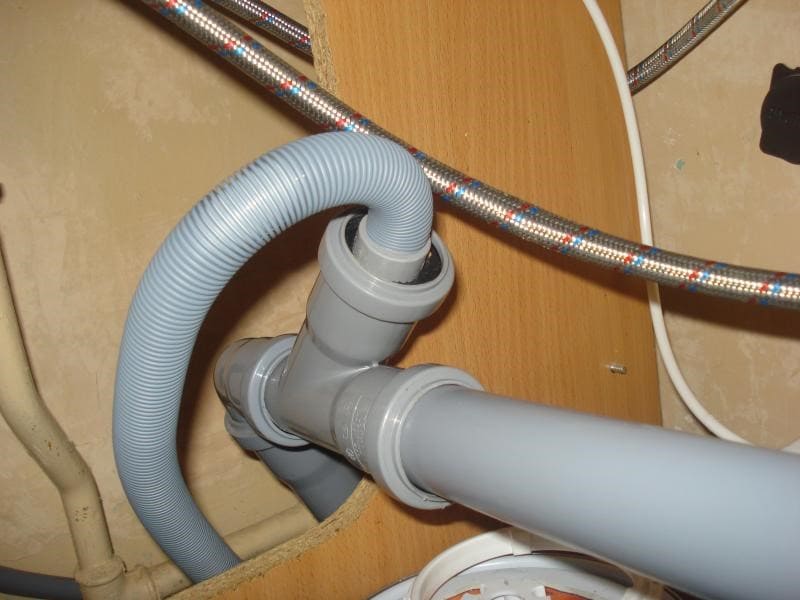
The washing machine has just been purchased and connected, and the owner has noticed a problem with the constant supply of water, then it is worth checking that the drain hose is connected correctly to the sewer networks.
The instructions for household appliances indicate that the drain hose must be at a height from the floor of no less than 50 cm. Its location at a shorter distance threatens the appearance of a “siphon effect”. Then the water flows out of the tank by gravity, the water level sensor is constantly activated, and the machine draws water again and again. The solution to the problem is the correct location of the drain hose. Washing machines are often equipped with special holders into which the drain hose is inserted so that its location is correct.
Damage to the water level sensor
If the washing machine is not new, but has been connected for a long time and worked perfectly, then the reason for the constant supply of water is a malfunction in the internal components of the equipment.A special sensor – a pressure switch – controls the amount of water entering the washing machine tank. The principle of its operation is as follows: as soon as the water level in the tank reaches the desired level, the sensor sends a signal and the water supply stops.
The pressure switch fails as a result of contact closure, leakage, or malfunction of sensor parts. This breakdown can be easily fixed at home. Before starting work, you should read the detailed instructions for replacing the pressure switch in washing machines.
Valve failure
If the washing machine draws water into the tank even when it is turned off, then the problem is in the inlet valve. With such a breakdown, more water will be consumed than with the breakdown of other machine parts. If the valve is working properly, it shuts off the water supply when the tank is filled to the required level. The faulty part cannot cope with this task, and water flows constantly. To prevent water from overflowing, an emergency drain is triggered, and so on without stopping.
The valve itself cannot be repaired, because this part is subject to mechanical wear. Even if it is possible to temporarily restore its functionality, it will not last long. The part is simply replaced with a new one. It's better to do this once than to constantly climb inside the machine. When purchasing a valve, keep in mind that the new part must be absolutely similar to the old one. It is worth buying clamps for it along with the valve, since the old ones will most likely be damaged during the removal process.
The control module has failed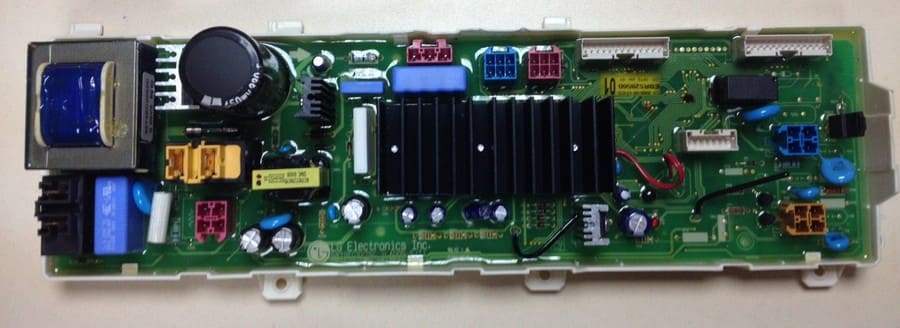
The worst thing is if the problem in the constant supply of water occurs due to problems with the control unit of the washing machine.In this situation, the control unit does not control the operation of the sensors, it does not send commands to the parts or does it incorrectly. The control unit may fail due to a sudden surge in power supply, drops of water falling on the board, or simply some mechanical damage.
Self-repair at home is impossible. You need special equipment and skills to correctly replace the control unit. In addition, before installation, the new unit requires installing the firmware for a specific model of washing machine.
How to find and eliminate the cause of the breakdown?
The easiest way to detect the cause of the problem of constant water supply is visually. It is enough to check that the drain hose is higher than the machine drum. If this is not the case, then simply lift and secure it at a height of 50 cm from the floor or higher.
Sometimes it can be difficult to see where the water drain hose is located. In this case, you can determine the problem as follows: turn on any washing program, wait for the tank to fill with water. After this, select the water drain mode. About halfway through the draining process, you need to pause and listen. If you hear that water continues to flow out, then the drain hose is located low and its position needs to be adjusted. If the cause of the malfunction is the location of the drain hose, then such repairs can be done at home.
If the water level sensor is faulty, you need to look for the cause inside the washing machine. When starting to troubleshoot, disconnect the washing machine from the power supply.
A malfunction of the pressure switch or the tube leading to it is one of the common problems with washing machines. You will need to remove the back cover of the washing mashine, there is a sensor on the upper left side.
It is a cylinder with a rubber membrane. Do not rush to disconnect it from the contacts. First, check for oxidation, sometimes it is enough to clean the contacts, and the sensor will return to normal. Inspect the pressure switch tube. If there are cracks, seal them. If the tube is clogged inside, disconnect it and blow it out well. Check the rubber membrane, it should be intact. If the contacts and tube are OK, then the part needs to be replaced.
The sensor itself is marked with the manufacturer's name. When buying a spare part, you should be guided by the inscriptions on the sensor.
The procedure for replacing the pressure switch: disconnect the tube, compression chamber, terminals and unscrew the bolts. Remove the faulty part and install a new one in the reverse order. 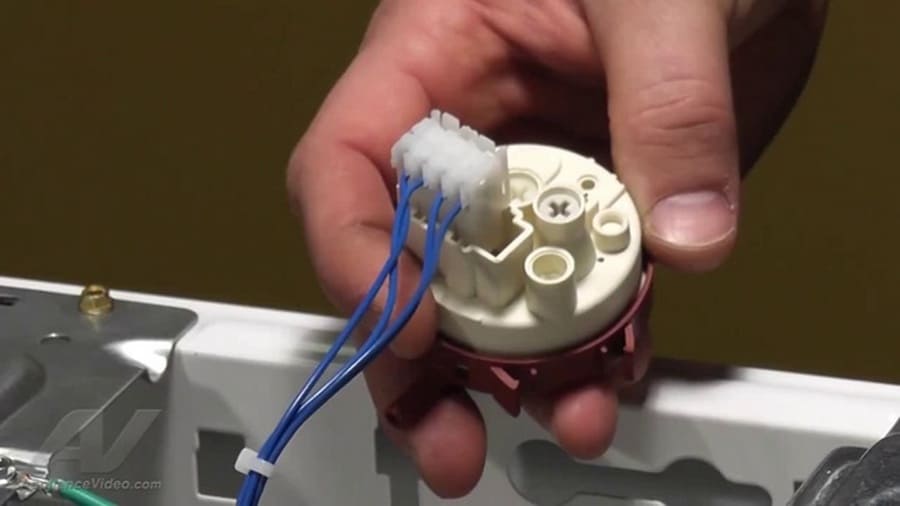
If the washing machine fills with water even when turned off, then the problem is in the inlet valve. There can be 2 types of problems with this part: low water pressure due to the membrane on the valve, or water quickly fills up due to a faulty valve.
To get to the valve, you will have to remove the cover of the washing machine. In models with vertical loading - the side cover. The valve will be located at the bottom. In models with front loading - the top cover, the valve is directly under it. We take out the valve, having previously disconnected the wires and fasteners from it. In the reverse order, a new inlet valve is installed, and we proceed to check the operation of the machine. Be sure to start any washing program.
Unfortunately, if after checking the drain pipe, water level sensor and inlet valve the problem is not found, then there is a high probability that the problem is that the control unit of the washing machine is broken. You will not be able to cope with this on your own.The unit can only be properly replaced by a service center specialist. This part cannot be repaired.
In some models of household appliances, when water is constantly added, an error may appear on the display.
Reasons why a washing machine fills with water and immediately drains
As we have already found out, the reasons for this behavior of household appliances can be either problems with incorrect installation or with the internal components and parts of the washing machine. This process can go on endlessly until the cause is eliminated.
The washing machine is not connected correctly
If you connect the washing machine yourself, the drain hose may not be installed correctly. Its end should be at a height equal to half the body of the machine. This is about 50-60 cm from the floor. If the hose is lying on the floor, then under the influence of pressure the water will flow out by gravity. An antisiphon will help solve this problem.
The sewer is clogged
If an impassable blockage has formed in the general house sewer system, then when waste is drained, low pressure will form in the pipe. This causes water to flow from the washing mashine tank into the sewer system to equalize the pressure in the pipes. The amount of water in the tank decreases, the water level sensor sends a signal that more water needs to be added, and water filling begins.
This problem can be solved simply: either clean the sewer (you will have to do this anyway), or disconnect the drain pipe of the machine from the sewer and organize a drain into the bathtub or toilet.
Breakdown of the pressure switch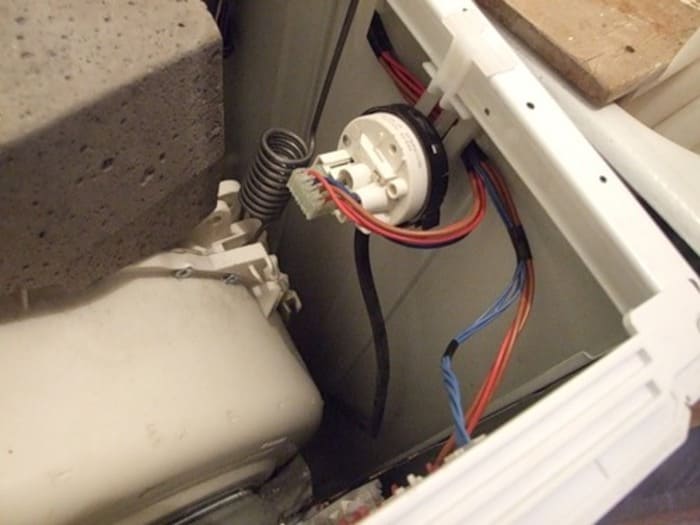
The command to fill the tank with water does not reach the control unit due to a faulty water level sensor. The sensor tube may be clogged, or the part itself may be damaged. The problem is solved inside the washing machine.If the problem is a blockage, then simply clean the tube from dust and dirt. And if the problem is with the pressure switch, then it is better to replace it. Repairs can only solve the problem for a short time.
The inlet valve is faulty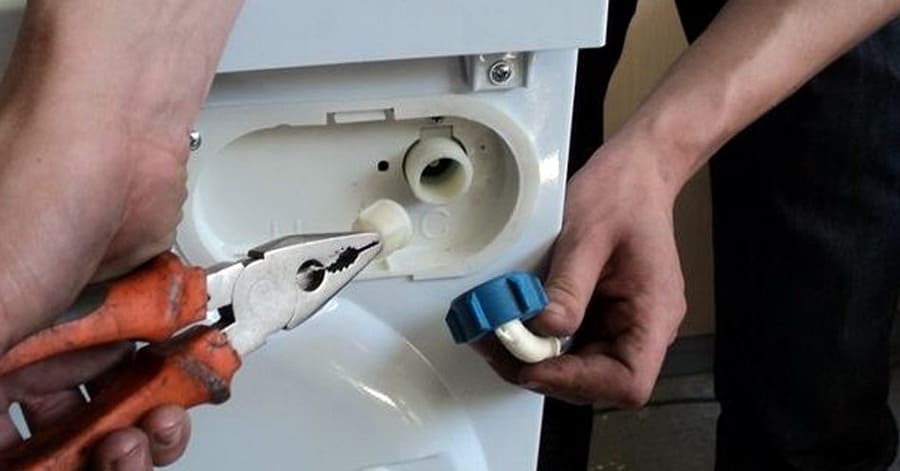
Diagnosing this problem is simple: the machine is turned off and water is poured into it. This is evidenced by the characteristic noise of water in the pipes. If water is drawn slowly, then the problem is in the inlet valve diaphragm. But intensive water intake indicates the need to replace the valve itself. The intake valve is not repaired. A new part is put in its place.
The washing machine tank is leaking
If, while the equipment is operating, a large puddle is discovered underneath it, then a problem with the constant supply of water may occur due to holes in the machine’s tank. Sometimes the gasket between the walls of the tank does not fit tightly, and water leaks out. Although the tank body looks strong, it can be easily damaged by sharp or hard objects forgotten in pockets when washing things. If the hole is small, you can seal it with sealant. As a temporary solution to the problem, this method is suitable. If the damage to the drum is significant, then it is better to install a new tank at a service center.
The electronic module has failed
In modern washing machines, the control unit issues commands to various systems and controls their execution. If the block is broken, then the entire operation of the machine is disrupted. Commands are either not executed or executed incorrectly. The causes of block failure are high humidity and mechanical damage. This part is replaced at a service center.
Conclusion
The constant supply of water to the washing machine is a serious problem. Its solution must be approached responsibly so as not to harm or aggravate the situation with household appliances.If skills and knowledge in this area are not enough, then it is better to contact washing machine repair specialists.









